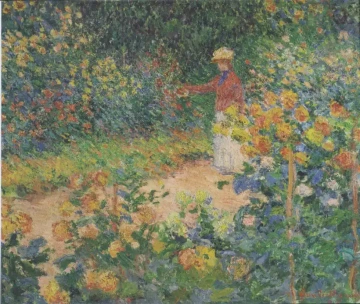Monet’s Passions, the Giverny Garden, and Visiting Prague
August 1, 2024
He transformed nature to make one of the most beautiful paintings in the history of art. Learn more about Claude Monet’s obsession with flowers and nature, his garden in Giverny, and the Monet Marmottan garden in Kitagawa. Discover Monet in the National Gallery Prague and pay a visit to GIYOU GARDEN, a unique Czech garden of jewellery flowers inspired by a historic homestead in Czechia.

Claude Monet (1840 in Paris - 1926 in Giverny)
Unhappy with the way painting was taught at art academies, he found his own way by painting outside, surrounded by nature. Employing the en plein air style (painting outside under the open sky), he was fascinated with the way light affects objects, and went on to become a pioneer of the French impressionist movement. He experienced both success and poverty, war in Algeria, the death of his wife and son, lived in Paris, Le Havre, Argenteuil, and London, and founded a garden in Giverny where he later died. His Giverny house became the property of the French Academy of Fine Arts, or more specifically the Claude Monet Foundation. Most of his paintings were bequeathed to the Marmottan Monet Museum.
Photo: Monet and his garden, approximately in 1917, authored by Étienne Clémentel (1864–1936), Courtesy of Wikipedia

Monet’s obsession with flowers and nature
“It may very well be that I became a painter thanks to flowers,” wrote Claude Monet.
He loved spending time outside, and would plant flowers and garden wherever he lived. When he rented a house in Vétheuil, he made an agreement with the owner to refurbish the terraces facing Seine. He also drew a lot of inspiration from trees.
Monet’s love of flowers wasn’t limited just to his garden. He’d often paint still lives featuring flowers (e.g. Water Lilies or Sunflowers). He painted flowers as living objects, capturing the play of light, colours, and fine surfaces in a unique way.
Photo: Femme au jardin, C. Monet, 1867, Courtesy of Wikipedia
Monet’s garden in Giverny
Monet transformed nature to fit his vision and made one of the most beautiful paintings in the history of art.
In 1883, he moved to Giverny, a small village 80 km from France, and founded a beautiful garden there. At first he was renting the house, but when he came into money he bought it and began transforming the garden. He hired first two, and eventually six gardeners. As the size of his staff grew, so did his collection of flowers he’d mail order or have delivered from abroad.
Monet would plan the layout carefully and consult botanists. The Giverny garden started looking more and more like an English landscape garden and Monet would cover every inch with flowers. Later, he created his dream water garden, complete with Japanese bridges, water lilies, irises, and bamboo.
The garden featured regular flower species (such as daffodils, pansies, and tulips), as well as cacti and oriental poppies. Showing a clear Japanese influence, he preferred cherries, maples, and apple trees. Water lilies, however, were center stage and over time became the focal point of Monet’s life. One story goes that the water garden had a dedicated gardener who’d clean the pond and wash the lilies by submerging them every single day.
Visiting Giverny
Monet spent 40 years of his life in the Giverny garden, digging, planting, and painting. Today, the place is a national landmark and open to the public. You can visit it from April to November, as does half a million people every year. Learn more about the Giverny garden here.
It’s a 10-minute journey from the house to Monet’s grave. It’s inconspicuous, always covered with flowers, its tombstone claiming the painter is “missed by everyone”.
Monet’s garden in Giverny, France. Authored by World3000. Courtesy of Wikipedia. Water Lilies and Japanese Bridge, C. Monet, 1897 -1899, Courtesy of Wikipedia
Japanese influence and the Kitagawa garden

Monet’s garden in Kitagawa
After Japan reopened its ports to Western trade in 1854, Europe was swept by the Japonisme fad. Monet, for one, was fascinated both by Japan and Japanese art (e.g. Hokusai, Utamaro, Hiroshige). Even his water lily pond with bridges was inspired by Japanese engravings. He never visited Japan, however.
The Marmottan garden in the village of Kitagawa is the world’s only garden outside France authorised by the Claude Monet Foundation to bear the painter’s name. Inspired by Monet’s garden in Giverny, the Marmottan is divided into two parts - a water garden (boasting the same bridge Monet built in Giverny), a flower garden, and the Bordighera garden. It’s an hour drive to the Marmottan from the Kochi airport and is well worth a visit if you ever happen to be nearby.
Photo: Monet’s garden Marmottan in Kitagawa, Aki District, Kōchi, Japan, author: 京浜にけ at Japanese Wikipedia, Courtesy of Wikipedia
National Gallery in Prague

The largest collection of art in Czechia
The National Gallery in Prague has exhibitions in seven different buildings—the Sternberg palace, the Kinsky Palace, th Salm Palace, the Waldstein Riding School, the Convent of St. Agnes of Bohemia, and the Trade Fair Palace. You can see Monet’s paintings in the new building of the Trade Fair Palace.
The National Gallery has 399,000 collection items, including a number of art gems by, for example, Albrecht Dürer, Vincent van Gogh, Paul Gauguin, Paul Cézanne, Edvard Munch, Pablo Picasso, or such Czech authors as Václav Hollar, Josef Václav Myslbek, Toyen, or František Kupka.
The National Gallery in Prague has two paintings by Monet—Orchard in Bloom, and Two Women Among Flowers. The latter depicts a flower bush where two women seem to be “drowning” —the painter’s wife Camille and her friend. Both paintings can be found in the new building of the Trade Fair Palace of the National Gallery.
Photo: Two Women Among Flowers, C. Monet 1875, National Gallery in Prague, Courtesy of Wikipedia
GIYOU GARDEN in Prague
Unique Czech flowers of silver and gold, inspired by a garden surrounding a historic homestead

GIYOU inspiration and passion
GIYOU was born in 2022, at a charming historic homestead in Bohemia, hidden in a small village of only 15 houses. The founders’ inspiration to start creating jewellery flowers sprung from the thousands of blooms growing in their beautiful garden.
Almost immediately, the flowers’ beauty, originality, and masterful craftsmanship earned them appreciation from celebrities and the media. Extraordinary commissions soon followed (e.g. the. world-unique bouquet of 118 flowers, made of pure gold). The founders’ dream blossomed into a business which would go on to sell flowers all over the world.

Walking around our garden, and gifts from Prague
GIYOU GARDEN is located in downton Prague - a one minute walk from the Wenceslas Square or a three minute walk from the Old Town Square, making a visit an obvious choice once you’re done enjoying the National Gallery. After inspecting Monet’s water lilies, you can examine our jewellery snowdrops, daisies, ryegrass, cornflowers, lavender, forget-me-nots and learn about their potential as a unique souvenirs to bring home from Prague.
GIYOU
Radek Bláha







